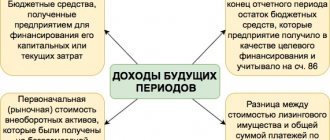In this article we will consider the question of how to take into account deferred expenses in 1C 8.3 “Enterprise Accounting 3.0”. RBPs in the 1C Accounting 8.2 program are reflected in the same way, so you can use this instruction for older versions of 1C.
Deferred expenses (FPR) are expenses that we took into account in the current period, but in this regard we plan to receive income in the future. In other words, you spent money today in order to receive income tomorrow.
Such expenses do not necessarily have a direct impact on profits. For example, we bought a domain (domain name) with the goal of deploying a website for our company. The purpose of the site is to attract customers who will generate income for us. Since the site must first be created and then “promoted,” it will begin to generate profit only after some time. The costs of purchasing a domain are deferred expenses.
Write-off of deferred expenses is carried out in three ways:
- monthly, within a certain date range;
- daily (meaning calendar days), within a certain date range;
- in an arbitrary (special) way. As a rule, this means a one-time write-off.
These settings are specified in the reference book of the same name “Future Expenses”.
Let's start getting acquainted with taking into account future expenses with this reference book and filling it out.
The concept of future expenses and the nuances of their recognition and write-off
Future expenses or, as they are commonly called, deferred expenses (FPR) are expenses incurred by the company in past and (or) current periods and subject to write-off in subsequent time periods.
RBP are an object of accounting, although mention of such a term is rarely found in accounting and tax regulations. For example, it is absent in the Tax Code, IFRS, and Law No. 402-FZ dated December 6, 2011 on accounting.
Find out how to take into account future expenses in ConsultantPlus. If you do not have access to the K+ system, get a trial online access for free.
Based on the definition formulated by legislators in paragraph 65 of the regulations on accounting and reporting, approved by order of the Ministry of Finance of Russia dated July 29, 1998 No. 34, expenses incurred in the reporting period relating to subsequent reporting periods are written off according to the scheme established for writing off the value of the assets of this species, during the time period to which they belong.
Classification of RBP and determination of algorithms for their write-off is a procedure based on detailed knowledge of the legislation and practical experience of an accountant (financial specialist).
The absence in the legislation of a specific list of costs classified as RBP gives rise to various approaches by accountants of different companies to reflecting and writing off RBP in accounting and reporting.
Since the set of costs incurred by different companies depends on the specifics of the activities of a particular company, the nuances of recognizing BPR and the algorithm for accounting for them may differ. These features must be provided for by including in the accounting policy a separate section dedicated to this issue.
When starting the process of classifying RBP, you should be guided by the requirements of the following regulatory documents:
- accounting provisions containing a direct reference to the recognition of RBP (PBU 2/2008, 14/2007).
- PBU 10/99 “Expenses of an organization”, approved by order of the Ministry of Finance of Russia dated 05/06/1999 No. 33n (clause 19), establishing the use of an approach in accounting based on the uniform recognition of expenses.
The costs that fall into the category of RBP on the basis of these groups of regulatory documents will be discussed in more detail in the next section.
Unified form No. INV-11 - form and sample
Accounting documents Expand the list of categories Subscribe to a special free weekly newsletter to keep abreast of all changes in accounting: Join us on social media.
That is why, when creating a new type of product/service, it is more correct to use standard/established names, or those accepted at the enterprise. Follow the hyperlink in the corresponding column of the table.
networks: VAT, insurance premiums, simplified tax system 6%, simplified tax system 15%, UTII, personal income tax, penalties We send letters with the main discussions of the week > > > August 07, 2021 Documents and forms will help you: INV-11 - a unified document used in inventorying future expenses periods. We will tell you in our article what its specifics are and where you can download it.
Using the INV-11 form, an act is drawn up in which the inventory commission records information about expenses of future periods - those that are actually incurred one-time, but are expensed over several periods (months, years).
The form of the document in question was approved by Decree of the State Statistics Committee of the Russian Federation dated August 18, 1998 No. 88. It is filled out in 2 copies.
The first is sent to the accounting department, and the second remains at the disposal of the commission, which conducts the inventory.
Representatives of the relevant commission, as well as the financially responsible person, sign both copies. To fill out the INV-11 form, accounting records for account 97 and information obtained when checking this data during the inventory are used. For information on the document establishing the subject, time frame for conducting the inventory and the composition of the commission carrying it out, read the article.
Difficulties in recognizing costs and the algorithm for writing them off
The following expenses can be safely recognized as future expenses (since this is directly stated in the legislation):
- For preparatory work - carried out in connection with upcoming projects. They are written off as revenue under the contract is recognized (clause 16 of PBU 2/2008 “Accounting for construction contracts”, approved by order of the Ministry of Finance of Russia dated October 24, 2008 No. 116n).
- In the form of a one-time (fixed) payment - for the right obtained by the company to use the results of intellectual activity (or means of individualization). It is recognized as expenses during the period of validity of the agreement (clause 39 of PBU 14/2007 “Accounting for intangible assets”, approved by order of the Ministry of Finance of Russia dated December 27, 2007 No. 153n).
In relation to other costs, which are written off evenly, their classification as part of the BPR requires a serious analytical approach from the accountant.
The main difficulty with this classification is whether to consider incurred costs as an asset or to recognize an expense? The following algorithm can help you figure this out, helping to classify costs as an asset:
- find out whether this asset will bring economic benefits to the company in the future;
- determine the degree of its control (whether the company has the right to receive cash inflows from its use in the future, as well as limiting access to such benefits for other persons).
At the same time, the company is likely to have future economic benefits if it has the opportunity to:
- use the asset in the activities of the company;
- repay their obligation or exchange;
- distribute the asset among the owners of the company.
If costs do not meet the criteria of an asset, they are recognized as expenses.
Correct classification will help to avoid errors in the reflection of RBP in financial statements, as well as to apply the necessary method for their write-off.
To clarify this difficult task, officials of the Russian Ministry of Finance gave the following explanations (letter dated January 12, 2012 No. 07-02-06/5):
- if the costs incurred by the company comply with the conditions for recognizing a certain asset established by accounting standards, these costs are reflected in the balance sheet as part of this asset (fixed assets, intangible assets, inventories) and are written off in the manner established for writing off the value of this asset;
- in other cases, costs are reflected in the balance sheet as BPR and written off by their reasonable distribution between reporting periods in accordance with the algorithm established in the accounting policy.
Get acquainted with international approaches to asset valuation using the materials on our website:
- “IFRS No. 38 Intangible assets - application features”;
- “IFRS No. 16 Fixed assets - application features”.
Inventory in 1C 8.3 Accounting 3.0
Every accountant deals with inventory. It can be held either at the end of the year or during it.
From the article you will learn:
- how to conduct an inventory of property and liabilities in 1C;
- how to reflect its results;
- How to carry out an inventory of fixed assets step by step in 1C 8.3 Accounting.
Inventory in 1C 8.3
All property and liabilities of the organization are subject to inventory. Inventory can be carried out in different sections of accounting:
- cash;
- settlements with counterparties;
- goods and materials;
- OS, etc.
Depending on the section, the list of documents used in the program will differ.
Cash inventory
There is no standard document for conducting an inventory of funds in 1C. For inventory, use the report Balance sheet for account 50 “Cash”, 51 “Cash accounts”, etc.
If according to the inventory results:
- If a shortage is detected, then to write it off, enter the document Cash withdrawal transaction type Other expense or Write-off from current account transaction type Other write-off .
- If surpluses are detected, then to capitalize them, enter the document Cash receipt transaction type Other receipt or Receipt to current account transaction type Other receipt .
Inventory of settlements with counterparties
To take inventory of settlements with counterparties, use the document Settlements Inventory Act in the section:
- Purchases - Settlements with counterparties - Inventory acts of settlements;
- Sales - Settlements with counterparties - Inventory reports of settlements.
Before taking inventory, it is recommended to check mutual settlements with counterparties using the Subconto Analysis report.
Inventory of goods and materials
To conduct an inventory of goods and materials, use the document Inventory of goods in the section Warehouse - Inventory - Inventory of goods.
If according to the inventory results:
- If a shortage is detected, then to write it off, enter the document Write-off of goods .
- surpluses are detected, then to post them, enter the document Posting of goods .
Inventory of fixed assets
Carry out an inventory of fixed assets using the document Inventory of fixed assets in the section OS and intangible assets - Accounting for fixed assets - Inventory of fixed assets.
On the Assets Fill button to specify a list of objects accepted for accounting as fixed assets in the specified division and assigned to the specified employee. If some objects are missing from the table section, add them using the Add .
On the Inventory , fill in:
- inventory period;
- on the basis of which document the inventory is carried out;
- the reason for the inventory.
On the Inventory Commission , fill out the composition of the inventory commission and mark the Chairman .
If according to the inventory results:
- If a shortage is detected, then to write it off, enter the document Write-off of OS ;
- surpluses are detected, then to capitalize them, enter the document Acceptance for accounting of fixed assets .
These documents can be entered based on the OS Inventory by clicking the Create based on .
How to capitalize surplus during OS inventory in 1C 8.3
For unaccounted fixed assets, enter the document Acceptance for accounting of fixed assets, transaction type Based on inventory results .
On the Non-current asset , specify:
- Method of admission - Other ;
- Income item is an item of other income and expenses with the Type of item Other non-operating income (expenses) ;
- Cost and Cost of NU - the market value of the fixed assets on the date of the inventory.
Filling out the remaining tabs is no different from accepting the OS as usual.
Postings
How to write off shortages during OS inventory in 1C 8.3
Write off the shortage using the document Write-off of OS .
In the document please indicate:
- Write -off account - 94;
- Reason for write-off - Shortage as a result of inventory , i.e. Why does the OS drop out?
Postings
When posting the document Write-off of fixed assets, the residual value will be determined, which will be written off as shortages.
Source: https://buhpoisk.ru/inventarizacija-v-1s-8-3-buhgalterija-3-0.html
Postings for writing off deferred expenses
After the procedure for classifying RBP, their value is reflected in accounting and is gradually written off using the following correspondence of accounts:
- Dt 97 Kt 60 (76) - costs are taken into account as part of the RBP;
- Dt 20 (25, 26, 44) Kt 97 - partial write-off of RBP.
An important nuance in this regard is the period for writing off the RBP. If it is not specified in the contract, it is determined independently, taking into account the method of writing off the RBP fixed by the accounting policy. This method can be used:
- algorithm for uniform write-off of RBP over the time established by order of the head of the company;
- the method of writing off RBP in proportion to sales income;
- other ways to write off RBP.
8.x BP Where to find inventory reports
LordMaverick said: ↑ Inventory report for deferred expenses = INV-11 is easily available on the Consultant’s website in the public domain Click to expand. Probably, what is needed is not the act itself, but the PF inserted into BP 3.0 https://fort.crimea.com/support/viewtopic.php?id=26 grit: Question: Is it possible in 1C 8.3 to generate an INV-11 expense inventory act future periods?
02/01/2017 Solution to the issue: This report is not provided in the program. It is searched for, download:
- for BP 2.0 and BP 3.0 https://legion-trud.ru/akt-inventari.ashodov-budushhih-periodov-inv-11-dlya-bp-3.0
- INVENTORY OF PREFERRED EXPENSES INV-11 Configuration: Enterprise Accounting 3.0 Platform version: 8.3 Cost, rub: Free Processing file: Download https://qa.erpstat.ru/design/1900/
We recommend reading: Who is the manufacturer if the barcode starts with 50
On infostart they sell it for 9 USD https://infostart.ru/public/779168/ en masse As it turned out, an accountant friend of mine bought it, but her employer did not pay for it.
She sells for 500 rubles at retail through friends, incl. and through me. Provided that I will not post it in the public domain for free Guarantees a refund for those who are dissatisfied Write, I will send a link to the archive in the cloud in exchange for a transfer of 500 rubles Or call - write to WhatsApp, Novosibirsk time +4 hours to Moscow: +7 (913)385 53 21 (whatsapp / phone / viber) (eMail) (Gennady) I copy from there to here: Almost all external printed forms (more than 80) for the Enterprise Accounting 3.0.57.17 configuration are supported
Displaying BPO in reports
Let's open the list of financial results reports.
Financial results and controlling / Financial results reports
In the subsection “Income and expenses, financial results” we will generate a report “Financial results” for the current month. It reflects the write-off of advertising expenses according to the specified distribution of the BPO.
We will generate the “Income and Expenses” report. It also displays written-off BPOs, including analytics (in the example, other expenses “Advertising on FM radio”).
Read our materials about other types of expenses: about transportation and procurement expenses, about the expenses of the current period, the transfer of workwear into operation.
yurburo61.ru
There is a possibility that the company will incur losses as a result of this operation.
It is recommended to pay attention to this when drawing up accounting policies for the next year.
For example, you can write the following phrase: current expenses are determined once at the time of their occurrence. What applies to advances issued There are several categories of expenses that are usually recorded in account 97 “Deferred expenses”. Most often these are advances issued.
Let's give a few examples. The organization transferred funds for an annual subscription to the magazine. At the moment, expenses are not yet considered, since this service has not yet been provided to the company. She listed the advance, which will be written off gradually from the moment the copies of the publication are received.
Next example. The entrepreneur enters into a lease agreement with the landlord for a period of four months.
This form has a standard structure for similar inventory forms and consists of a title section with general information, a table with a list of the types of assets being inspected and their distinctive features, as well as the signatures of responsible persons and commission members. Among the members of the commission there are usually employees of accounting, economic or technical departments, and a representative of the management team of the enterprise. It is not allowed to include in the commission financially responsible persons who are in charge of the assets being inspected.
The organization has the right not to use a unified form, but to prepare its own act form, which will reflect information about expenses for future periods.







